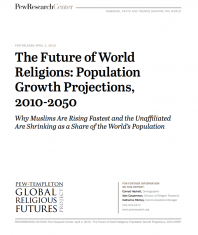
The Future of World Religions: Population Growth Projections, 2010-2050

This report was produced by the Pew Research Center as part of the Pew-Templeton Global Religious Futures project, which analyzes religious change and its impact on societies around the world. Funding for the Global Religious Futures project comes from The Pew Charitable Trusts and the John Templeton Foundation. The demographic projections within this report are based on the current size and geographic distribution of the world’s major religions, as well as age differences, fertility and mortality rates, international migration and patterns in conversion. For more information about how the projections were calculated, see the Methodology on page 166.
The religious profile of the world is rapidly changing, driven primarily by differences in fertility rates and the size of youth populations among the world’s major religions, as well as by people switching faiths. Over the next four decades, Christians will remain the largest religious group, but Islam will grow faster than any other major religion. If current trends continue, by 2050 …
- The number of Muslims will nearly equal the number of Christians around the world.
- Atheists, agnostics and other people who do not affiliate with any religion – though increasing in countries such as the United States and France – will make up a declining share of the world’s total population.
- The global Buddhist population will be about the same size it was in 2010, while the Hindu and Jewish populations will be larger than they are today.
- In Europe, Muslims will make up 10% of the overall population.
- India will retain a Hindu majority but also will have the largest Muslim population of any country in the world, surpassing Indonesia.
- In the United States, Christians will decline from more than three-quarters of the population in 2010 to two-thirds in 2050, and Judaism will no longer be the largest non-Christian religion. Muslims will be more numerous in the U.S. than people who identify as Jewish on the basis of religion.
- Four out of every 10 Christians in the world will live in sub-Saharan Africa.
These are among the global religious trends highlighted in new demographic projections by the Pew Research Center. The projections take into account the current size and geographic distribution of the world’s major religions, age differences, fertility and mortality rates, international migration and patterns in conversion.
- Issue:
- Demography, Urbanization and Migration
- Region:
- Global
- Year Published:
- 2015
- Institution:
- Pew Research Center

